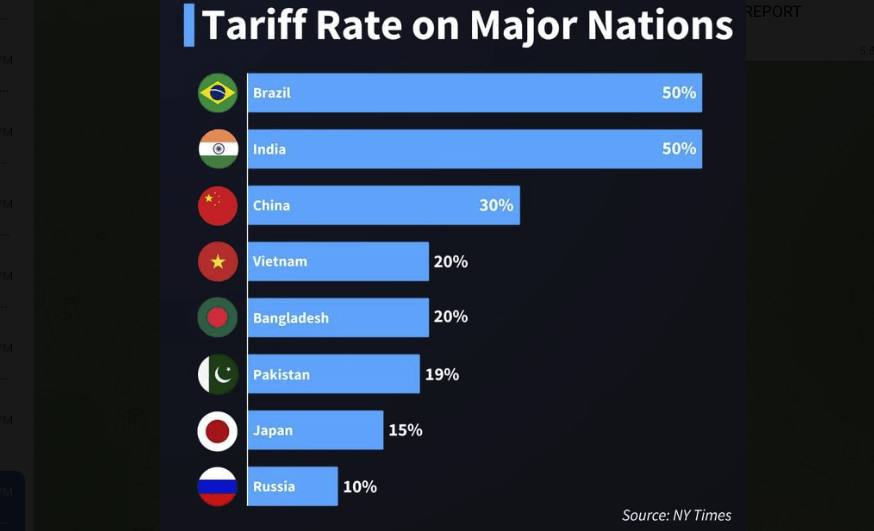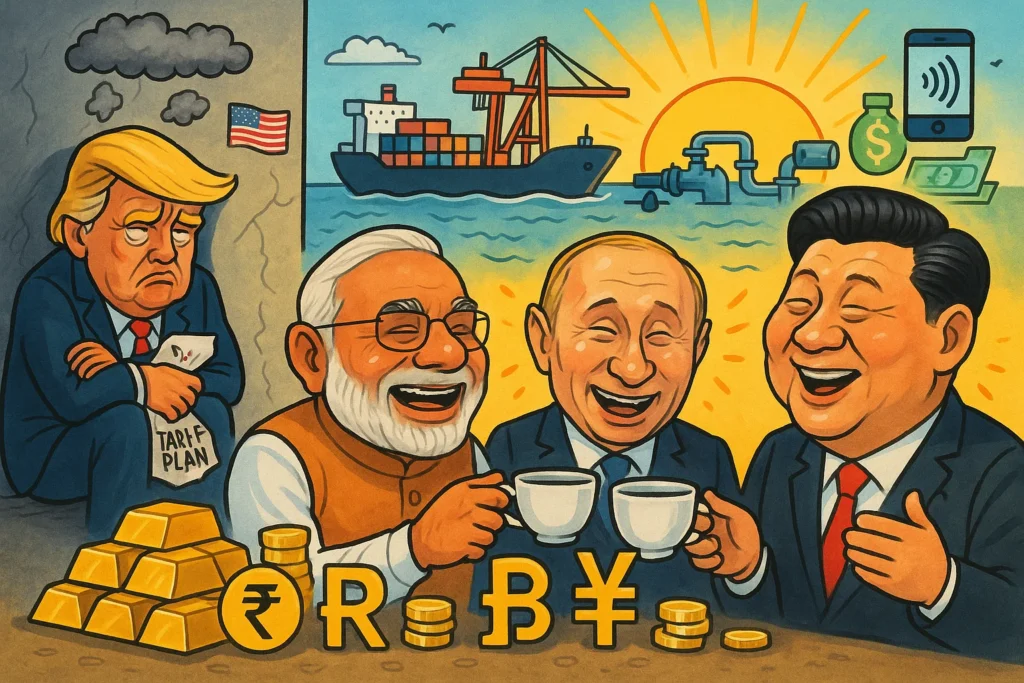Introduction – Geopolitics Meets Dalal Street
Imagine the stock market as a high-stakes cricket match. The pitch? Global trade. The players? The world’s biggest economies. And right now, India has just walked into a game-changing partnership with two powerful teammates—Russia and China.
As of August 2025, the Russia–India–China (RIC) alliance is back in action. This isn’t just a diplomatic reunion. It’s a bold response to US President Donald Trump’s latest tariffs—massive 10–50% duties on imports from over 60 countries. The move is rattling global supply chains, inflating prices, and forcing countries to rethink how they trade.

For India, this is more than politics. It’s about how the RIC Alliance impact on Indian stock market will play out in the months ahead. Oil prices, currency moves, and sector trends could all shift as these three giants tighten their economic grip. Investors on Dalal Street should be watching closely—because this alliance might just rewrite the rules of the game.
The RIC Alliance – What’s Really Happening
The RIC alliance—Russia, India, and China—isn’t some casual tea party. It’s a calculated move to push back against US economic dominance and the ripple effects of Trump’s aggressive tariff strategy.
This trio first formed a consultative forum years ago, but 2025 has given it fresh urgency. Russia is cut off from much of the West after the Ukraine conflict. China is locked in a trade battle with the US. India’s exports—from textiles to gems—are feeling the heat of protectionist walls. Together, they see a chance to create an Asian powerhouse that can sidestep Washington’s rules.

The plan isn’t just talk. Expect deeper trade pacts, tech collaborations, joint energy projects, and even coordinated military drills. Russia wants to avoid depending solely on China. China values India as a counterweight in Asia. India plays its favourite card—strategic autonomy—keeping trade channels open with everyone while dodging tariff damage.
For the Indian market, this alliance is more than diplomacy—it’s a potential catalyst. A stronger RIC means new trade flows, different currency routes, and fresh opportunities for sectors tied to global trade. The RIC Alliance impact on Indian stock market could be felt in oil refiners, defence companies, banks, and even infrastructure plays.
De-Dollarization – The Silent Market Mover
If the RIC alliance is the headline act, de-dollarization is the quiet revolution happening backstage. And make no mistake—it could shape the RIC Alliance impact on Indian stock market more than any press conference or handshake.
De-dollarization simply means reducing reliance on the US dollar for trade, reserves, and cross-border payments. For the RIC nations, it’s not just an economic preference—it’s a shield. After the US froze $300 billion of Russian assets post-Ukraine, the message was clear: if you depend on the dollar, you’re vulnerable.
Enter the BRICS+ toolkit. There’s the “BRICS Bridge,” a cross-border payment system that lets countries trade in local currencies. “BRICS Clear” offers settlements without touching the dollar. China is pushing the petro-yuan, already handling over 14% of global oil futures in its currency. Russia trades oil in rubles, India uses rupees for some crude deals, and Saudi Arabia plus the UAE are joining the club.
The real jaw-dropper? The “Unit” currency—announced at the 2024 BRICS summit—backed by 40% gold and 60% member currencies. If it gains traction, it could reduce dollar volatility in India’s oil imports, strengthen the rupee’s global role, and give RBI more room to maneuver.
For Indian investors, the message is clear: currency moves won’t just be about the USD/INR pair anymore. Watch how the rupee performs against the yuan, ruble, and even the new BRICS unit—it might decide the next rally or sell-off on Dalal Street.
Direct Impact on the Indian Economy
The RIC alliance isn’t just about political posturing—it’s about changing how money, goods, and resources move. And that shift could have a deep RIC Alliance impact on Indian stock market trends over the next few years.
Cheaper Oil Imports
If India can settle more crude purchases in rupees or through the BRICS unit, it could sidestep the dollar premium. That means oil refiners like IOC, BPCL, and HPCL might see better margins, which could ease inflationary pressures at home.
New Trade Routes
Closer ties with Russia and China could unlock new logistics corridors. This might reduce freight costs for exporters in textiles, agriculture, and pharmaceuticals—boosting competitiveness even as US markets turn more protectionist.
Stable Forex Flows
A reduced dependence on the dollar could make India’s external trade less sensitive to US rate hikes. This would help the RBI manage currency swings and keep borrowing costs steadier for Indian companies.
Technology & Defence Deals
Russia’s defence tech and China’s manufacturing expertise, combined with India’s engineering capabilities, could create new joint ventures. That spells opportunities for listed defence contractors, electronics makers, and engineering firms.
In short, this alliance isn’t a distant diplomatic headline—it’s a direct play on costs, competitiveness, and currency stability for India’s economy. And when those fundamentals shift, Dalal Street feels it.
Sector-Wise Impact on Indian Stock Market
Not every sector will feel the RIC wave the same way. Some could ride it to record highs, while others may struggle to adapt. Here’s how the RIC Alliance impact on Indian stock market might play out industry by industry:
a. Energy & Oil
Oil refiners like Indian Oil Corporation (IOC), BPCL, and HPCL stand to benefit if crude purchases shift away from the dollar. Settling oil in rupees or BRICS currency could lower import costs, boost refining margins, and reduce vulnerability to USD volatility.
b. Banking & Forex
Public sector banks such as State Bank of India (SBI) and Bank of Baroda could gain from increased cross-border settlements in local currencies. A stronger rupee trade network might open new revenue streams in forex transactions and trade finance.
c. Infrastructure & Logistics
With RIC-backed trade routes expanding, companies like Adani Ports, Container Corporation of India, and Gateway Distriparks could see higher cargo volumes and better utilization of assets.
d. Technology & Defence
Defence manufacturers such as HAL, Bharat Electronics, and Mazagon Dock Shipbuilders may win contracts through joint R&D with Russia and China. Electronics and semiconductor players could also see supply chain diversification benefits.
e. Commodities & Metals
Steel producers like Tata Steel and JSW Steel might benefit from cheaper raw material imports from Russia, bypassing dollar-linked price spikes.
For investors, these aren’t just sectoral stories—they’re entry points into the broader geopolitical shift. Positioning in these stocks early could mean catching the upside before the alliance’s impact is fully priced in.
Risks & Challenges
While the RIC alliance brings opportunities, investors need to factor in the flip side. Here’s a quick risk matrix:
| Risk Factor | Description | Potential RIC Alliance Impact on Indian Stock Market |
|---|---|---|
| US Retaliation | The US could impose secondary sanctions on countries or companies dealing heavily with Russia and China. | Export-oriented sectors like IT and pharma could face reduced US market access, triggering stock volatility. |
| China Dependence | Closer RIC ties might increase India’s reliance on Chinese imports in electronics, machinery, and chemicals. | Negative sentiment towards Chinese exposure could hurt companies in electronics manufacturing and auto components. |
| Geopolitical Tensions | Border disputes or political disagreements could disrupt RIC cooperation. | Defence and infrastructure stocks tied to RIC projects may see sudden sell-offs. |
| Currency Volatility | A shift away from the dollar could cause unpredictable currency swings in rupee, yuan, and ruble pairs. | Forex-sensitive sectors like oil, aviation, and IT services could face earnings pressure. |
| Slow Policy Execution | BRICS payment systems and the “Unit” currency may take years to scale. | Delayed benefits could keep related stock rallies muted in the short term. |
The takeaway? The RIC Alliance impact on Indian stock market isn’t a straight line upward—it’s a mix of tailwinds and turbulence that smart investors need to navigate.
Conclusion – From Tariffs to Transformation
Trump’s tariffs were meant to protect American jobs. Instead, they may have united his biggest rivals into a powerful economic bloc. For India, the RIC alliance offers both opportunities and challenges. Cheaper oil, new trade routes, and a stronger rupee role could boost sectors from energy to defence. But over-dependence on China or a sudden geopolitical flare-up could just as easily rattle the markets.
One thing is certain—the RIC Alliance impact on Indian stock market will not be a background story. It will shape investor sentiment, sectoral trends, and even the rupee’s position in the global order. Dalal Street has seen foreign capital flows drive rallies before—but this time, the drivers might be alliances, currencies, and trade corridors, not just earnings reports.
For investors, that means one thing: the next big market move might not start in Mumbai or New York—but in a meeting room where Moscow, Beijing, and New Delhi shake hands.
FAQs on RIC Alliance Impact on Indian Stock Market
1. What is the RIC Alliance?
The RIC Alliance is a strategic cooperation between Russia, India, and China, aimed at boosting trade, technology, and security ties while reducing reliance on the US dollar.
2. Why does the RIC Alliance matter for Indian investors?
It could influence oil prices, currency stability, and export competitiveness, directly affecting sectors like energy, defence, banking, and infrastructure on Dalal Street.
3. How does de-dollarization play into this?
By trading in local currencies or a BRICS-backed unit, India could cut dollar-linked costs, protect against sanctions, and strengthen the rupee’s role in global trade.
4. Which Indian sectors could benefit the most?
Energy refiners, PSU banks, logistics firms, defence contractors, and select metal producers may gain from stronger RIC ties.
5. What are the main risks of the RIC Alliance for India?
Potential US retaliation, increased dependence on Chinese imports, currency volatility, and delays in policy execution are key challenges.
Related Articles
Trump’s Tariff Shockwave: How Indian Stocks & Sectors Will Be Hit or Rise
Tariff and Great Depression: Will History Repeat?
25% Tariff on India: Trump Targets Indian Exports – Sector & Stock Impact






